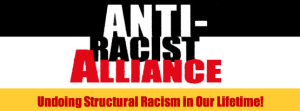6 Key Points for Anti-Racism Work (and Why It Connects to Sexual and Domestic Violence Prevention)
Last week, our own Leona Smith Di Faustino wrote about the deadly shooting of 18-year-old Michael Brown by a police officer in Ferguson, Missouri. She said:
This has to be talked about after all, because systemic violence spreads out like a cancer until it infects all aspects of society.
As someone who grew up, studied in, and worked in and around St. Louis, Missouri, I keep asking myself how we can fix this. How can we fix the system? How can we undermine the systemic and social conditions that allow for this type of lethal inequality to thrive? In a city and county like St. Louis, with such an obvious history of blatant racism that impacts the lives of its residents in real, and deadly, ways, how can we promote strong communities where people feel safe, are safe, are healthy, and will thrive?
While I certainly do not have the answers, it seems to me that asking the question is a good start. Violence isn’t inevitable. The racism that causes violence isn’t inevitable. Shaking our heads isn’t enough. What are we going to do?
 This is most certainly an issue of public administration. What can we do to improve our systems so preventable tragedies like the killing of Michael Brown can’t happen? In the process of asking that question, a colleague sent me a paper from The Anti-Racist Alliance. The Alliance, formed in New York to address systemic racism in the world of social work and public services, offers countless anti-racism resources and a web-based curriculum on whiteness. In fact, just some months ago, The Alliance published a helpful paper, Think Creatively and Act Decisively: Creating an Antiracist Alliance of Social Workers. Again, while this paper centers on experience organizing and training social workers, it offers guidance for all service providers, sharing 6 points that have been central to the Anti-Racist Alliance’s work:
This is most certainly an issue of public administration. What can we do to improve our systems so preventable tragedies like the killing of Michael Brown can’t happen? In the process of asking that question, a colleague sent me a paper from The Anti-Racist Alliance. The Alliance, formed in New York to address systemic racism in the world of social work and public services, offers countless anti-racism resources and a web-based curriculum on whiteness. In fact, just some months ago, The Alliance published a helpful paper, Think Creatively and Act Decisively: Creating an Antiracist Alliance of Social Workers. Again, while this paper centers on experience organizing and training social workers, it offers guidance for all service providers, sharing 6 points that have been central to the Anti-Racist Alliance’s work:
- Envision Something Awesome
- You Have a Role
- You Cannot Do It Alone
- There is Different Work for Different People In Your Group
- Develop and Nurture Systems of Accountability
- You Do Not Need Critical Mass; You Need Gatekeepers Who Can Open Up A System
Read the short paper and visit The Alliance’s website to learn more about these key points.
It’s interesting…as I considered sharing this resource, I felt I had to defend its inclusion on PreventConnect; as if anti-racism tools and resources don’t contribute to sexual and domestic violence prevention work. Well, that’s certainly wrong and my concern is telling. Sexual and domestic violence are manifestations of oppression, of societal norms about who has a right to use power and how. Those very norms are screaming out from Ferguson, asking us what we’re going to do about it, and creating conditions that allow evils like sexual violence to occur. Where there is racism, we will find violence. To prevent both, we need to strike at the root. Leona said it best:
This tragedy of a life cut short because of the “isms” that permeate our world doesn’t need to be weaved into the fabric of sexual violence prevention to create a teachable moment for you the reader.
What will you do about it? What will we all do about it? If you’re not sure, The Anti-Racist Alliance is a place to start.
Share your resources, suggestions, and other places to start in the comments below.
